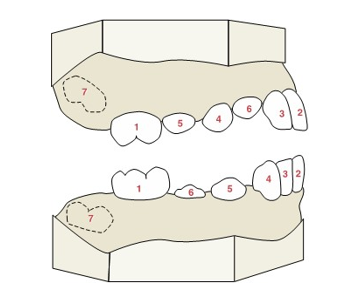dental embryology, histology, and anatomy Ch 1 and 15 quiz
1/44
There's no tags or description
Looks like no tags are added yet.
Name | Mastery | Learn | Test | Matching | Spaced |
|---|
No study sessions yet.
45 Terms
dentition
used to describe the natural teeth in the jaws
a person has two dentitions during a lifetime: primary and permanent dentition
primary dentition (baby teeth)
primary school ~ first school = primary dentition ~ first set of teeth
20 teeth in total
8 incisors
4 canines
8 molars
NO premolars
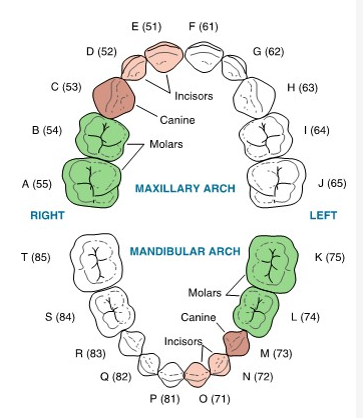
permanent dentition (adult teeth)
second dentition to develop
32 teeth in total
8 incisors
4 canines
8 pre molars
12 molars
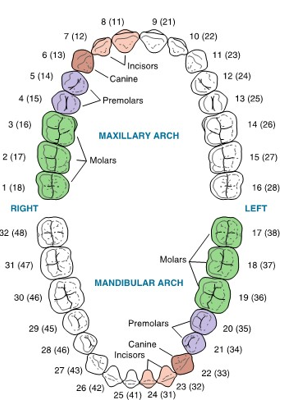
universal numbering system (UNS)
united states - universal
Starts on patients upper right side, 1-16, then dropping down to mandible starting at 17-32
primary dentition follows the same pattern, using letters A-T
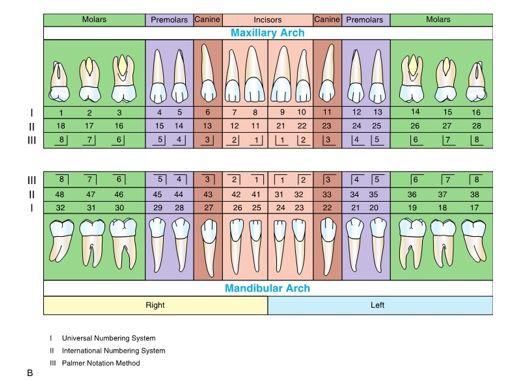
international numbering system (INS)
teeth are designated from each other by using a two digit code
the first digit corresponds to the specific quadrant the tooth lies in, with the second number indicating the position of the tooth in the quadrant
for example: the right central maxillary incisor would be tooth “11”
primary dentition starts first quadrant at 5
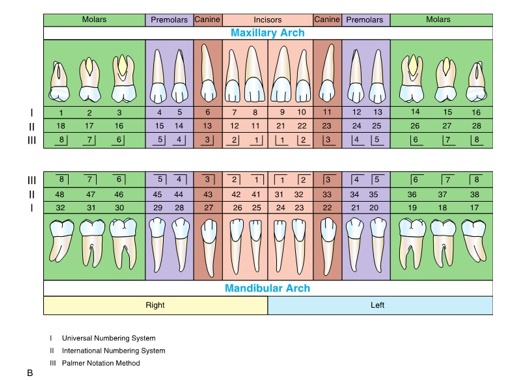
palmer notation method
known as the military tooth numbering system
teeth are designated from each other with a right-angle symbol indicating the quadrants and arch with tooth number placed inside
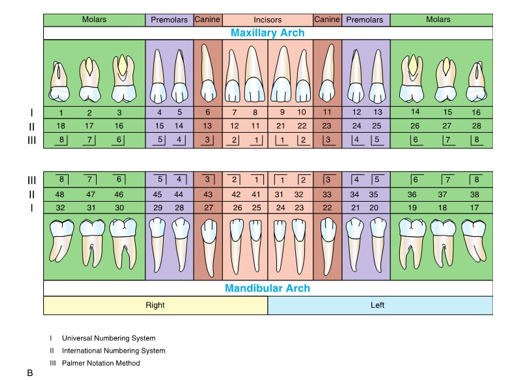
dentition periods
there are two dentition, but three dentition periods
primary
mixed
permanent
mixed dentition period
~6 to 12 years
eruption of permanent mandibular first molar (6-year molar)
primary and permanent
fastest and most noticeable
primary dentition period
~6 months to 6 years
eruption of primary mandibular central incisor
primary
beginning
permanent dentition period
After ~ 12 years
shedding of last primary tooth
usually permanent
slowest and least noticeable dentition period
dental anatomy
is the area of the dental sciences dealing with the morphology or form of the teeth, both the crown and root. Restorative dentistry uses many specific dental anatomy terms when discussing treatment and pathology.
alveolus
Alveolar process means bone.. it needs an alveoLUS because the tooth needs less bone (hole) for the tooth to go in
surrounds and supports each tooth
the bone of the tooth socket
located in the alveolar process (tooth bearing part of each jaw)
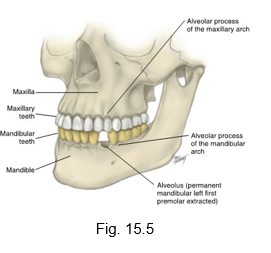
occulsion
is the method by which the teeth of the mandibular arch come into contact with those of the maxillary arch

mandible
man down! (lower jaw)
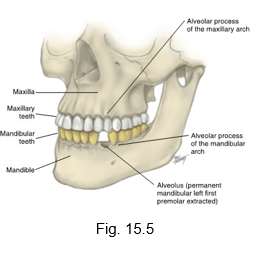
D-A-Q-T system
is based on the tooth within its quadrant
D for dentition (primary, permanent)
A for arch (maxillary or mandibular)
Q for quadrant (1st,2nd,3rd, or 4th)
and T for tooth type (molar, premolar, canine, incisor, etc)
ex: (D) permanent, (A) mandibular, (Q) left (T) first premolar
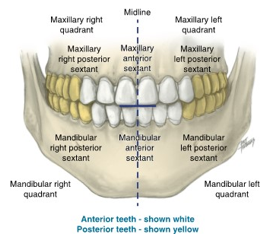
sextants
further divide each dental arch into three parts according to the relationship with the midline
each arch is divided into left and right
central six incisors and canine are considered “anterior” or “front facing” sextant
remaining molars and considered either left or right posterior sextant
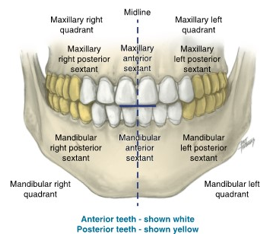
crown
each tooth consists of a crown and one or more roots
can be seen on the top of the tooth (CROWNS the tooth)
each crown has dentin covered by enamel
dentin meets enamel at dentinoenamel junction (DEJ)
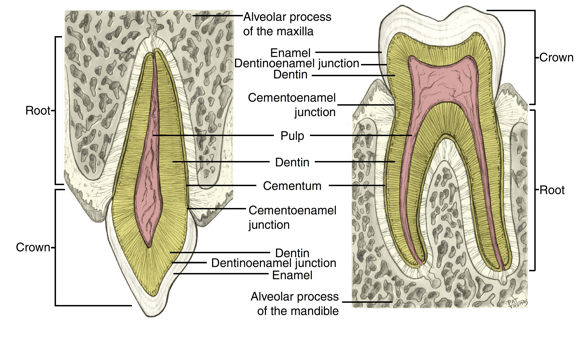
root
each tooth consists of a crown and one or more rooths
the root consists of dentin surrounded by cementum
the cementum meets the enamel at the cementoenamel junction (CEJ)
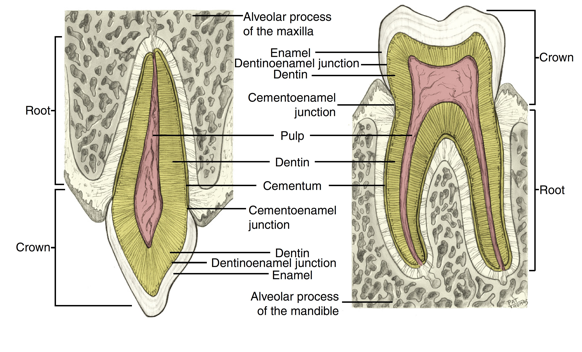
pulp cavity
consists of a pulp chamber, pulp canal or canals, an apical foramen, and possibly a pulp horn
covered by dentin
consists of nerves, blood vessels, and the connective tissues of the tooth
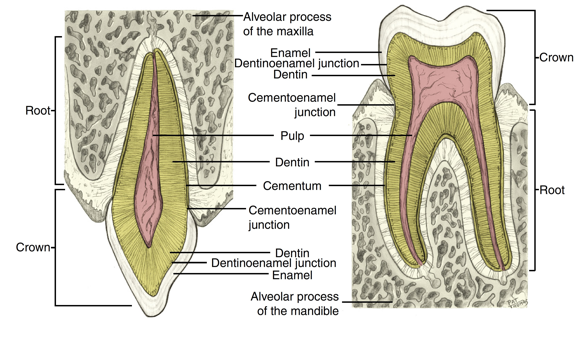
anatomic crown
anatomy never changes
is the entire part of the tooth that is covered by the enamel
stays constant except for attrition and other physical wear
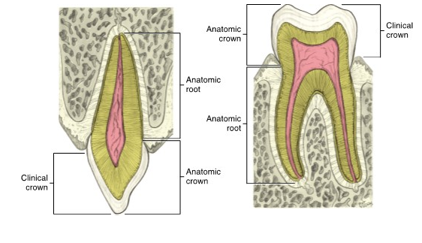
clinical crown
is the part of the anatomic crown that is visible and not covered by the gingiva
height is determined by the location of the marginal gingiva
depends on health of patient
“what is visible?”
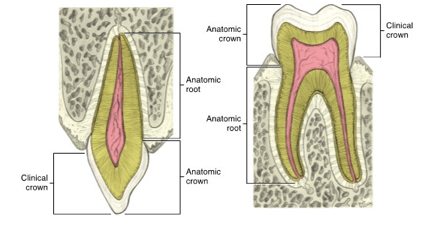
apical
the tip of the tooth’s root
the hole that the pulp and nerves use to enter the alveolar process
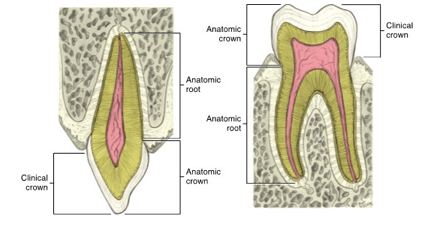
restorations (clinical connection)
certain restorations may cover the entire anatomic crown area; these are full artificial crowns (caps)
post and core may be placed within the crown and root to help with the buildup of restorative material to support an individual restoration
root concavities
many surfaces of the roots have depressions or root concavities
these indentations in the root surface commonly occur on the proximal root surfaces of anteriors and posteriors and the buccal and lingual surfaces of molars
an area between two or more of these roots is a furcation
should be CAREFULLY explored during instrumentation appointments and charted
crown lengthening (clinical connection)
a full artificial crown should ideally cover the entire prepared anatomic crown, but enlarges gingival tissue or loss of anatomic crown structure may require a surgical periodontal procedure called crown lengthening to increase the amount of the clinical crown and reduce the surrounding gingival tissue by removal
masticatory surface
Is the chewing surface on the most superior surface of the crown
incisal surface for anterior teeth
occlusal surface on posterior teeth
both have lineal elevations (ridges) which are named according to location
cusps
the masticatory surfaces of both canines and posterior teeth have at least one major elevation; a cusp
cusps contribute to a significant part of the tooth’s surface
mesial
the surface of the specific tooth closest to the midline
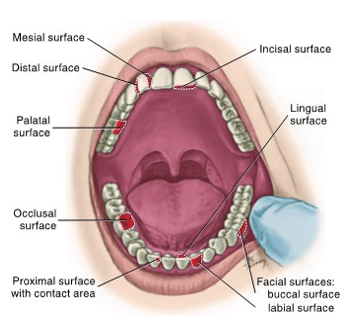
distal
the surface of the specific tooth farthest from the midline
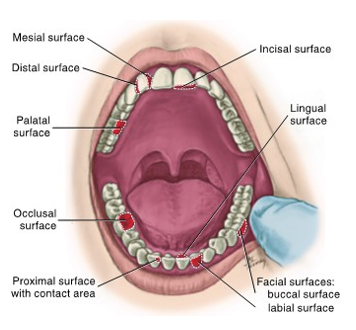
proximal
together, both the mesial and distal surfaces between adjacent teeth are considered the proximal
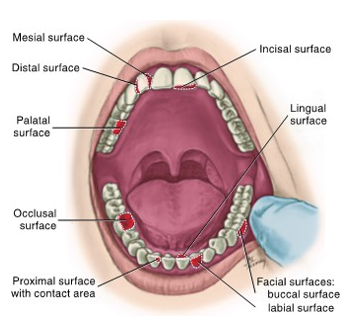
interproximal space
the area between adjacent tooth surfaces
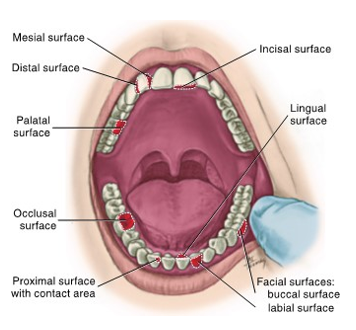
contact areas
the area where the crowns of adjacent teeth in the same arch physically touch on each proximal surface is the contact area, or as referred to by clinicians, the contact
(the clicking sound you hear when flossing between teeth and resistance felt are due to strong contacts)
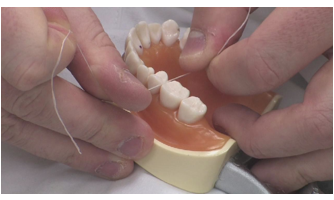
height of contour
crest of curvature
is the greatest elevation of the tooth either incisocervically or occulsocervically on a specific surface of the crown when viewing its profile from the labials or buccal and the lingual
embrasures
when two teeth in the same arch come into contact, the curvatures next to the contact areas form spaces considered embrasures.
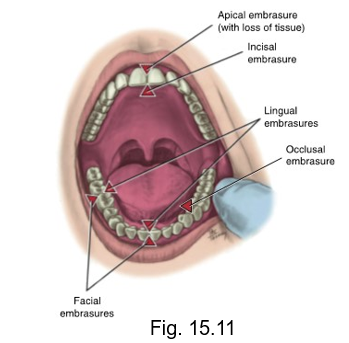
line angle
is formed by the lines created at the junction of two crown surfaces and the name is derived by combining the names of the two surfaces
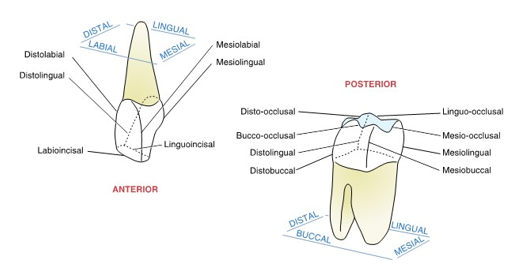
point angle
is another way to determine the specific area of the crown
the junction of three surfaces of the crown, the point angle takes its name from those three surfaces
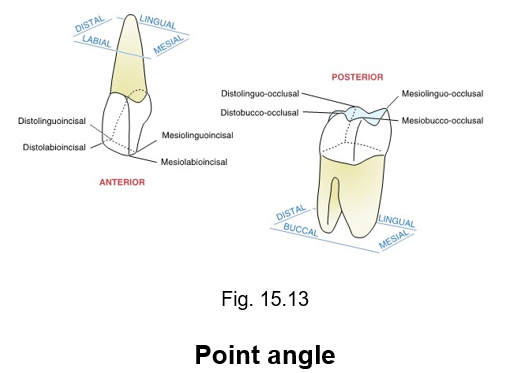
thirds
a crown can be divided both horizontally and vertically into three parts, or thirds, to designate specific tooth areas
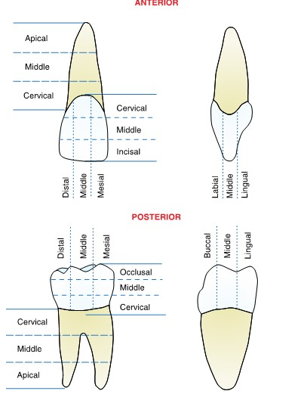
tooth form
related to the function during mastication for the tooth type, as well as to its role in speech and esthetics
the form and function of each tooth type are similar for both the primary and permanent dentitions
incisors
instruments for biting and cutting food during mastication (triangular proximal form of their crowns)
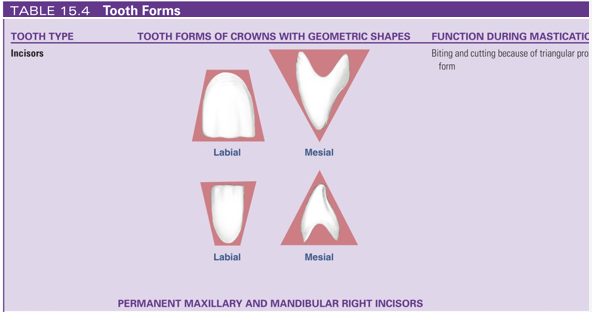
canines
because of the tapered shape and the prominent cusp of their crowns, function to pierce or tear food during mastication
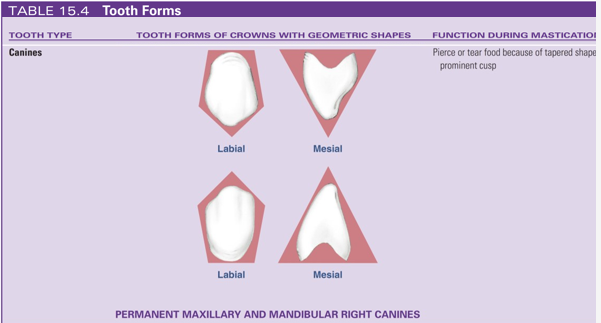
premolars
only found in permanent dentition
assist canines in piercing and tearing food because of prominent cusps of their crowns during mastication
assist molars in grinding food due to wide masticatory surface (occlusal surface)
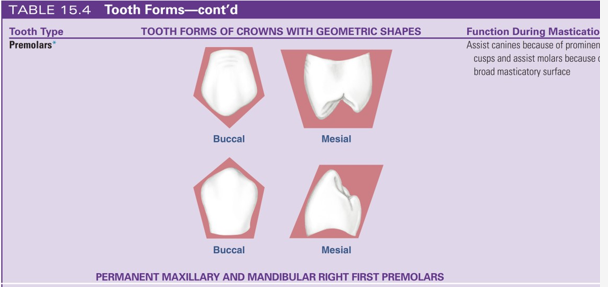
molars
the molars function in grinding food during mastication, assisted by the premolars
the wide masticatory surface, the occlusal surface of the molars, with the prominent cusps, function during mastication

root axis line (RAL)
an imaginary line representing the long axis of a tooth, drawn in a way to bisect the root (and thus the crown) in the cervical area into two halves
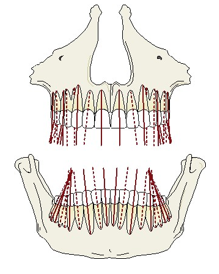
primary tooth eruption sequence
bottom central incisors (6-10 months)
upper central incisors (8-12 months)
upper lateral incisors (9-13 months)
lower lateral incisor (10-16 months) and upper first molar (13-19 months)
lower first molar (14-18 months)
upper canine (16-22 months)
lower canine (17-23 months)
lower second molar (23-21 months)
upper second molar (25-33 months)
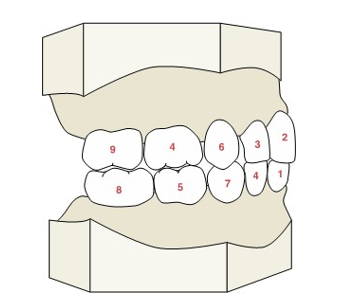
permanent dentition eruption
first molars (6-7 years)
2. lower central incisor (6-7)
2. upper central incisor (7-8)
3. lower lateral incisor (7-8)
3. upper lateral incisor (8-9)
4. lower canine (9-10)
4. upper first premolar (10-11)
5. lower first premolar (10-12)
5. upper second premolar (10-12)
6. upper canine (11-12)
6. lower second premolar (11-12)
7. second molar (11-13)
8. third molar (17-21)
W 12 6 6 12 W
W 12 6 6 12 W
